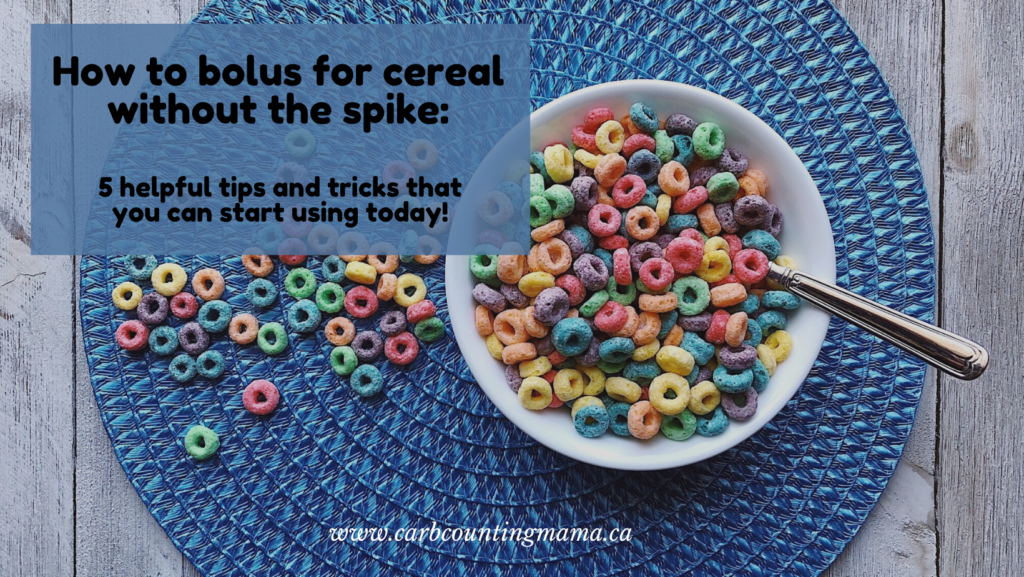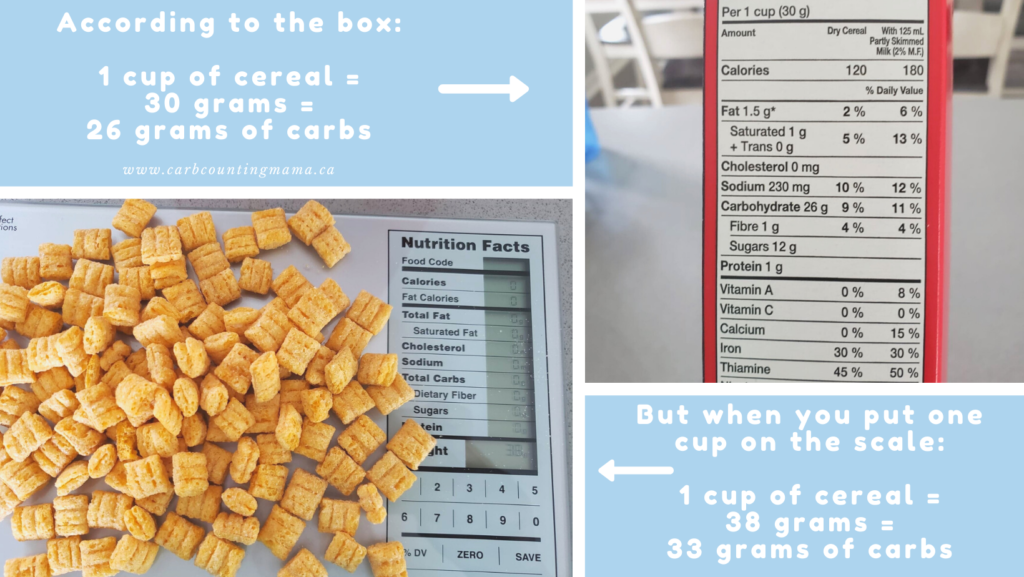Over and over again, I hear people saying that “cereal is the devil” or “don’t eat cereal, it’s impossible to bolus for cereal”. I’m not a huge fan of cereal myself, but lots of people eat it on a daily basis. And I’ll let you in on a little secret… people with T1D can eat it daily as well. Without the dreaded spike. If you learn how to bolus for cereal, you can take back your breakfast! Here are 5 easy tips to get you started.

This post contains affiliate links
1. Before you eat, make sure you’re in range.
And by “in range” I don’t mean the range you have set for yourself. I mean non-diabetic range. We’re talking 4-7 mmol/L (72-126 mg/dL). Starting on the lower end of that range is the best way to set yourself up for success.
I know this is easier said than done. BUT, it makes a huge difference. Regular basal testing can be really helpful and it’s the first step to taking control of your blood glucose numbers.
If you go into the meal high, your insulin has to work hard to bring down that bg AND take care of the cereal. When your blood glucose is in range, that makes it easier on your body, your insulin, and your level of stress. If your blood glucose isn’t high when you bolus for cereal, the insulin just covers the cereal instead of getting all used up as part of the correction dose.
Likewise, if you’re low before eating, it can make things complicated as well. You either have to treat the low, which can make the spike worse once you add cereal to the mix, or… you can’t pre-bolus. This brings us to tip #2.
2. Pre-bolusing is your friend
Pre-bolusing is an important aspect of diabetes management. I’d say it’s the second most important thing to get in the habit of, next to making sure your basal is set correctly. Knowing how your insulin works, and knowing the macro content in the food you eat means you can pair the insulin and food to “hit” at the same time.
Cereal is almost entirely simple carbs. Unless you get boring grown-up cereals with lots of nuts and whole grains, there is very little protein or fat in cereal. Because of this, cereal is actually “quick in, quick out” and if you have a dry cup of cereal, it peaks close to the same time as most fast-acting insulins.
** Know your insulin onset time. Jordan uses Fiasp, which starts working within 5 minutes. He rarely needs to prebolus, and if he does, it’s a matter of a few minutes. Many other fast-acting insulins take 20-30 minutes to start working.**
Cereal tends to be a bit quicker than most insulins. So, if you give a bit of a pre-bolus (you’ll have to experiment with this but it shouldn’t be more than 15-20 minutes and will often be quite a bit less), you can pair the insulin and cereal nicely. The type of milk you use for your cereal will affect the pre-bolus timing as well, so pay attention to what’s in your milk as well!
But, pre-bolusing is hard. You have to wait to eat and you’re STARVING!
Don’t worry, the next tip will deal with your hunger and help avoid the spike.
Related: The Cereal Experiment: Is Cereal Really “The Devil”?
3. Lead with protein
Scrambled eggs, bacon, or sausages are great to eat while you’re waiting for that pre-bolus. Added bonus: the protein will help curb the spike too!
This tip is well known from the book Sugar Surfing. Dr. Ponder is a T1D himself as well as an endocrinologist. He suggests using protein to help avoid blood glucose spikes.
If you want to avoid spikes from “quick in, quick out” foods, try leading with protein to help flatten that line.
4. Before you bolus for cereal, measure, measure, measure!
Swagging won’t work for this. You can’t eyeball a bowl of cereal and say, “oh, that looks like 2 units of insulin.”
And forget about those measuring cups! Did you know that when you use measuring cups to figure out the carbs in your cereal, you can be off by 20+ grams of carbs per cup!?
20+ grams of carbs per cup?? That can’t be right… can it?
Take a look at the picture below. Just to see how different the numbers would be, I measured out a cup of Captain Crunch cereal in a measuring cup. I did my best to make it exactly 1 cup. According to the box, a cup should be 26 grams of carbs. But when I put that “cup” of cereal on the scale, it turned out to be almost 21% MORE cereal than what the box indicated. That’s a huge difference. No wonder people have trouble with cereal spikes.

Figuring out your carb count using measuring cups or measuring spoons is often quicker, but it will vary each time you do it. Weighing it on the scale will be the same every time.
Don’t have a food scale? Here’s one that is highly recommended in the T1D community: Food Scale
5. Experiment with timing and carb ratios
Dealing with T1D requires a lot of experimentation. What works one day might not work the next, but you’ll get a good idea of what to expect in certain situations.
If you get a spike with a 5 minute pre-bolus, maybe you need to do a 10 minute pre-bolus next time.
If there are spikes regardless of protein, pre-bolusing, and precise measurements, maybe you need to adjust your carb ratio for cereal… or for that time of day overall.
Find a cereal that you’d like to conquer and take notes every day. When did you dose? What number did you start at? What time was it? When did you start eating? Adjust what you’re doing each day based on your notes. After a few days, you should see your cereal spike reducing or disappearing completely.
People with T1D can eat whatever they want
And they can do so without huge blood glucose swings. It takes time and practice, but if your goal is to eat what you want and stay in range while doing it, you can!
The more you practice with different types of foods, the easier it is to predict what will happen with new foods that are similar in carbs, protein, and fat.
Of course, not everyone has the time and patience to do this. Or maybe you’d like cereal once in a while, but figuring out how to bolus for cereal is too much work.
If all else fails, try low-carb cereals!
They’re easy on blood glucose numbers and taste just like regular cereal… although they’re more pricey.
A couple of favorites in the T1D community are Magic Spoon Cereal and HighKey Protein Snacks – Keto Breakfast Cereals.
Cereal isn’t the devil
In fact, no food is the devil. Some foods are just more tricky to bolus for. Rest assured, if you want to eat it, there’s a way to bolus for it! And your blood glucose numbers don’t have to suffer.
Happy Carb Counting!
~ Leah
Do you still eat cereal since your T1D diagnosis? Are there any tips you’d add to this list? Tell us in the comments!
For more tips and stories about T1D, join the Carb Counting Mama email list, and make sure to head over to the Carb Counting Mama Facebook page and “like” it.
Leave a Reply